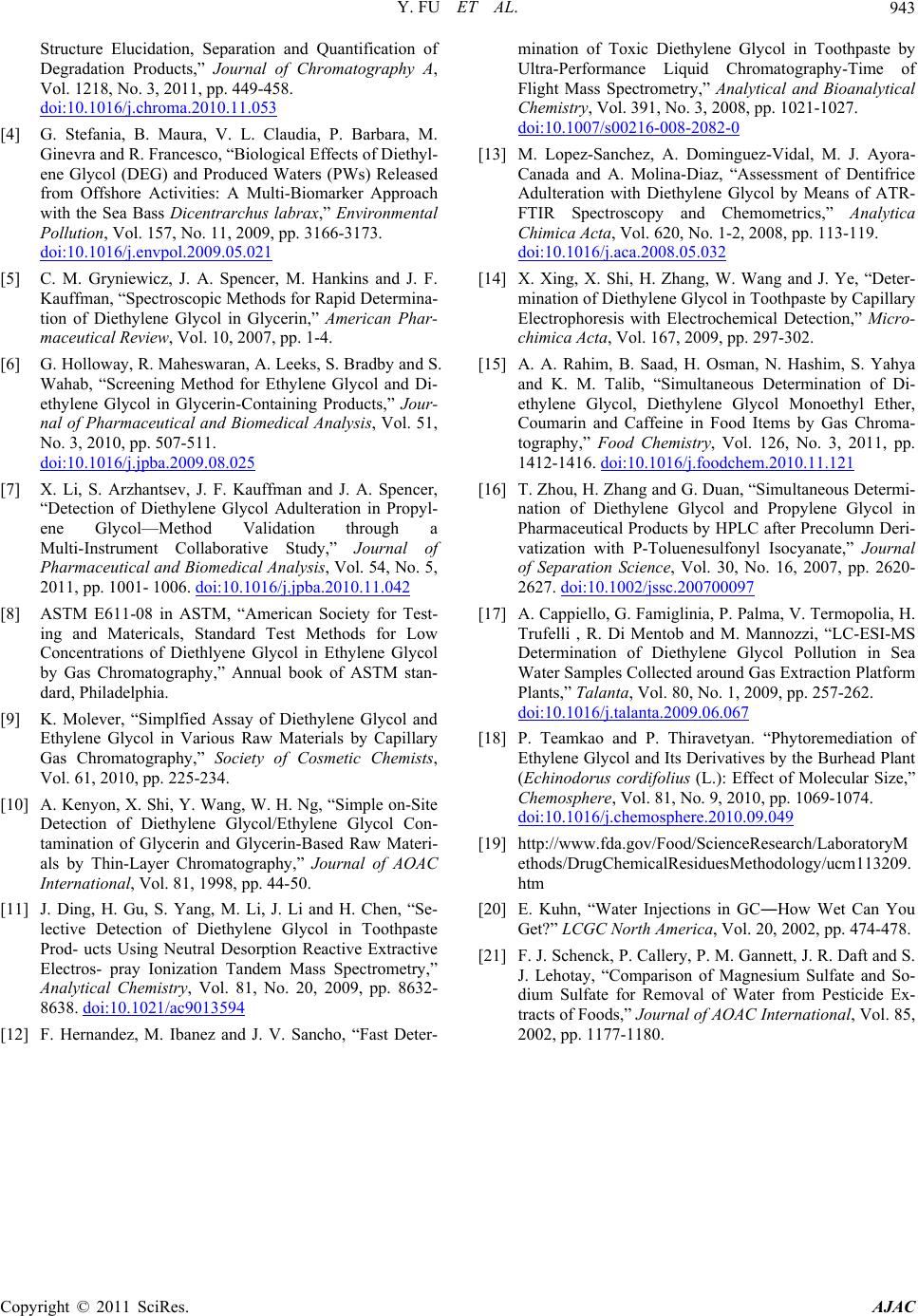
Y. FU ET AL.
Copyright © 2011 SciRes. AJAC
943
Structure Elucidation, Separation and Quantification of
Degradation Products,” Journal of Chromatography A,
Vol. 1218, No. 3, 2011, pp. 449-458.
doi:10.1016/j.chroma.2010.11.053
[4] G. Stefania, B. Maura, V. L. Claudia, P. Barbara, M.
Ginevra and R. Francesco, “Biological Effects of Diethyl-
ene Glycol (DEG) and Produced Waters (PWs) Released
from Offshore Activities: A Multi-Biomarker Approach
with the Sea Bass Dicentrarchus labrax,” Environmental
Pollution, Vol. 157, No. 11, 2009, pp. 3166-3173.
doi:10.1016/j.envpol.2009.05.021
[5] C. M. Gryniewicz, J. A. Spencer, M. Hankins and J. F.
Kauffman, “Spectroscopic Methods for Rapid Determina-
tion of Diethylene Glycol in Glycerin,” American Phar-
maceutical Review, Vol. 10, 2007, pp. 1-4.
[6] G. Holloway, R. Maheswaran, A. Leeks, S. Bradby and S.
Wahab, “Screening Method for Ethylene Glycol and Di-
ethylene Glycol in Glycerin-Containing Products,” Jour-
nal of Pharmaceutical and Biomedical Analysis, Vol. 51,
No. 3, 2010, pp. 507-511.
doi:10.1016/j.jpba.2009.08.025
[7] X. Li, S. Arzhantsev, J. F. Kauffman and J. A. Spencer,
“Detection of Diethylene Glycol Adulteration in Propyl-
ene Glycol—Method Validation through a
Multi-Instrument Collaborative Study,” Journal of
Pharmaceutical and Biomedical Analysis, Vol. 54, No. 5,
2011, pp. 1001- 1006. doi:10.1016/j.jpba.2010.11.042
[8] ASTM E611-08 in ASTM, “American Society for Test-
ing and Matericals, Standard Test Methods for Low
Concentrations of Diethlyene Glycol in Ethylene Glycol
by Gas Chromatography,” Annual book of ASTM stan-
dard, Philadelphia.
[9] K. Molever, “Simplfied Assay of Diethylene Glycol and
Ethylene Glycol in Various Raw Materials by Capillary
Gas Chromatography,” Society of Cosmetic Chemists,
Vol. 61, 2010, pp. 225-234.
[10] A. Kenyon, X. Shi, Y. Wang, W. H. Ng, “Simple on-Site
Detection of Diethylene Glycol/Ethylene Glycol Con-
tamination of Glycerin and Glycerin-Based Raw Materi-
als by Thin-Layer Chromatography,” Journal of AOAC
International, Vol. 81, 1998, pp. 44-50.
[11] J. Ding, H. Gu, S. Yang, M. Li, J. Li and H. Chen, “Se-
lective Detection of Diethylene Glycol in Toothpaste
Prod- ucts Using Neutral Desorption Reactive Extractive
Electros- pray Ionization Tandem Mass Spectrometry,”
Analytical Chemistry, Vol. 81, No. 20, 2009, pp. 8632-
8638. doi:10.1021/ac9013594
[12] F. Hernandez, M. Ibanez and J. V. Sancho, “Fast Deter-
mination of Toxic Diethylene Glycol in Toothpaste by
Ultra-Performance Liquid Chromatography-Time of
Flight Mass Spectrometry,” Analytical and Bioanalytical
Chemistry, Vol. 391, No. 3, 2008, pp. 1021-1027.
doi:10.1007/s00216-008-2082-0
[13] M. Lopez-Sanchez, A. Dominguez-Vidal, M. J. Ayora-
Canada and A. Molina-Diaz, “Assessment of Dentifrice
Adulteration with Diethylene Glycol by Means of ATR-
FTIR Spectroscopy and Chemometrics,” Analytica
Chimica Acta, Vol. 620, No. 1-2, 2008, pp. 113-119.
doi:10.1016/j.aca.2008.05.032
[14] X. Xing, X. Shi, H. Zhang, W. Wang and J. Ye, “Deter-
mination of Diethylene Glycol in Toothpaste by Capillary
Electrophoresis with Electrochemical Detection,” Micro-
chimica Acta, Vol. 167, 2009, pp. 297-302.
[15] A. A. Rahim, B. Saad, H. Osman, N. Hashim, S. Yahya
and K. M. Talib, “Simultaneous Determination of Di-
ethylene Glycol, Diethylene Glycol Monoethyl Ether,
Coumarin and Caffeine in Food Items by Gas Chroma-
tography,” Food Chemistry, Vol. 126, No. 3, 2011, pp.
1412-1416. doi:10.1016/j.foodchem.2010.11.121
[16] T. Zhou, H. Zhang and G. Duan, “Simultaneous Determi-
nation of Diethylene Glycol and Propylene Glycol in
Pharmaceutical Products by HPLC after Precolumn Deri-
vatization with P-Toluenesulfonyl Isocyanate,” Journal
of Separation Science, Vol. 30, No. 16, 2007, pp. 2620-
2627. doi:10.1002/jssc.200700097
[17] A. Cappiello, G. Famiglinia, P. Palma, V. Termopolia, H.
Trufelli , R. Di Mentob and M. Mannozzi, “LC-ESI-MS
Determination of Diethylene Glycol Pollution in Sea
Water Samples Collected around Gas Extraction Platform
Plants,” Talanta, Vol. 80, No. 1, 2009, pp. 257-262.
doi:10.1016/j.talanta.2009.06.067
[18] P. Teamkao and P. Thiravetyan. “Phytoremediation of
Ethylene Glycol and Its Derivatives by the Burhead Plant
(Echinodorus cordifolius (L.): Effect of Molecular Size,”
Chemosphere, Vol. 81, No. 9, 2010, pp. 1069-1074.
doi:10.1016/j.chemosphere.2010.09.049
[19] http://www.fda.gov/Food/ScienceResearch/LaboratoryM
ethods/DrugChemicalResiduesMethodology/ucm113209.
htm
[20] E. Kuhn, “Water Injections in GC―How Wet Can You
Get?” LCGC North America, Vol. 20, 2002, pp. 474-478.
[21] F. J. Schenck, P. Callery, P. M. Gannett, J. R. Daft and S.
J. Lehotay, “Comparison of Magnesium Sulfate and So-
dium Sulfate for Removal of Water from Pesticide Ex-
tracts of Foods,” Journal of AOAC International, Vol. 85,
2002, pp. 1177-1180.